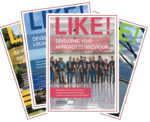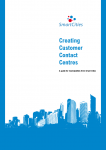
LIKE! supported the development of local ‘innovation cultures’ in cities across Europe. Our content strategy pulled together the findings and key lessons learned into a set of 4 magazines. Learn why we took this approach
With a focus on making content accessible to a wide audience, the magazines covered key themes and showcased the value of international collaborations within the project.

There’s a real expectation that cities and municipalities will be innovative – almost by default. Innovation requires skilled staff and a flexible organisation, so Like! explored ways to develop organisations to embed innovation in how they work and in how they design and improve services.

LIKE’s Smarter Services work developed new ways of working with citizens and service users to use data and information to complement efforts to co-design better services. There were three themes: 1) Data for Smarter services, 2) Local services, and 3) Channel and content strategies

LIKE! has been developing new ways for cities and communities to use data – to design and deliver better services, and to make better policy decisions for communities.
The ‘Creating Digital DNA’ work in LIKE! has focused on 3 areas: 1) Digital dashboards, 2) Local data for local services, and 3) the Internet of things (IoT).

Learn how BLING (Blockchain in Government) plans to accelerate and de-risk the development and deployment of blockchain-enabled e-services in the North Sea Region of Europe.

Key lessons in how to structure a high-risk project that keeps funders happy and give you flexibility in managing innovation programmes.

Like! aims to significantly enhance the capacity of the public sector to facilitate and deliver innovation, resulting in the development of a wide range of services using innovative solutions to deliver better public services.

I spent three years managing the Smart Cities Academic Network, which was set up to provide support to the Smart Cities Project. This case study summarises the SCAN approach and identifies the key outcomes.

Smart Cities prioritised improving customer services, adopting user profiling in service design/deliver, and exploring the potential of wireless services.
The project used a combination of co-design, targeted academic research, and mainstreaming/public engagement approaches to deliver high-impact and high-profile results that were used to make cities smarter across Europe.

Cities are working hard to become more customer-driven, and to change how they deliver services to respond better to their customers’ demands. This guide is an introduction to creating a customer contact centre, part of a broader shift in channel and service delivery strategies.

Customer Profiling and Customer Insight are key tools for cities to use to deliver better, more targeted and more effective services. This guide explains how to use these techniques.
The Smart Cities Academic Network developed a systemic, accessible approach to knowledge production and dissemination that was designed to accelerate the development of e-services and e-government in Europe.










